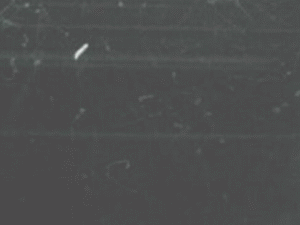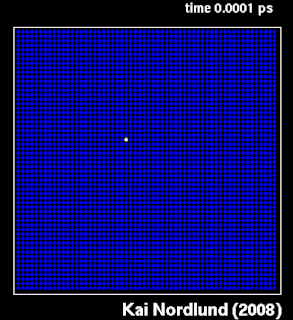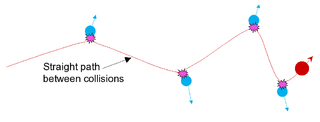Related Research Articles
In physics, an electronvolt is the measure of an amount of kinetic energy gained by a single electron accelerating from rest through an electric potential difference of one volt in vacuum. When used as a unit of energy, the numerical value of 1 eV in joules is equivalent to the numerical value of the charge of an electron in coulombs. Under the 2019 redefinition of the SI base units, this sets 1 eV equal to the exact value 1.602176634×10−19 J.
Particle radiation is the radiation of energy by means of fast-moving subatomic particles. Particle radiation is referred to as a particle beam if the particles are all moving in the same direction, similar to a light beam.
In physics, attenuation or, in some contexts, extinction is the gradual loss of flux intensity through a medium. For instance, dark glasses attenuate sunlight, lead attenuates X-rays, and water and air attenuate both light and sound at variable attenuation rates.
In physics, mean free path is the average distance over which a moving particle travels before substantially changing its direction or energy, typically as a result of one or more successive collisions with other particles.

A scintillator is a material that exhibits scintillation, the property of luminescence, when excited by ionizing radiation. Luminescent materials, when struck by an incoming particle, absorb its energy and scintillate. Sometimes, the excited state is metastable, so the relaxation back down from the excited state to lower states is delayed. The process then corresponds to one of two phenomena: delayed fluorescence or phosphorescence. The correspondence depends on the type of transition and hence the wavelength of the emitted optical photon.
Transition radiation (TR) is a form of electromagnetic radiation emitted when a charged particle passes through inhomogeneous media, such as a boundary between two different media. This is in contrast to Cherenkov radiation, which occurs when a charged particle passes through a homogeneous dielectric medium at a speed greater than the phase velocity of electromagnetic waves in that medium.
In physics, the radiation length is a characteristic of a material, related to the energy loss of high energy particles electromagnetically interacting with it.
Elastic recoil detection analysis (ERDA), also referred to as forward recoil scattering, is an ion beam analysis technique in materials science to obtain elemental concentration depth profiles in thin films. This technique is known by several different names. These names are listed below. In the technique of ERDA, an energetic ion beam is directed at a sample to be characterized and there is an elastic nuclear interaction between the ions of beam and the atoms of the target sample. Such interactions are commonly of Coulomb nature. Depending on the kinetics of the ions, cross section area, and the loss of energy of the ions in the matter, ERDA helps determine the quantification of the elemental analysis. It also provides information about the depth profile of the sample.

In dosimetry, linear energy transfer (LET) is the amount of energy that an ionizing particle transfers to the material traversed per unit distance. It describes the action of radiation into matter.
In passing through matter, charged particles ionize and thus lose energy in many steps, until their energy is (almost) zero. The distance to this point is called the range of the particle. The range depends on the type of particle, on its initial energy and on the material through which it passes.

In nuclear and materials physics, stopping power is the retarding force acting on charged particles, typically alpha and beta particles, due to interaction with matter, resulting in loss of particle energy. Its application is important in areas such as radiation protection, ion implantation and nuclear medicine.
Neutron depth profiling (NDP) is a near-surface analysis technique that is commonly used to obtain profiles of concentration as a function of depth for certain technologically important light elements in nearly any substrate. The technique was first proposed by Ziegler et al. to determine the concentration profiles of boron impurities in silicon substrates, and later improved by Biersack and coworkers to much of its existing capabilities.
The Bethe formula or Bethe-Bloch formula describes the mean energy loss per distance travelled of swift charged particles traversing matter. For electrons the energy loss is slightly different due to their small mass and their indistinguishability, and since they suffer much larger losses by Bremsstrahlung, terms must be added to account for this. Fast charged particles moving through matter interact with the electrons of atoms in the material. The interaction excites or ionizes the atoms, leading to an energy loss of the traveling particle.

A collision cascade is a set of nearby adjacent energetic collisions of atoms induced by an energetic particle in a solid or liquid.
The electron mass is the mass of a stationary electron, also known as the invariant mass of the electron. It is one of the fundamental constants of physics. It has a value of about 9.109×10−31 kilograms or about 5.486×10−4 daltons, which has an energy-equivalent of about 8.187×10−14 joules or about 0.511 MeV.
Stopping and Range of Ions in Matter (SRIM) is a group of computer programs which calculate interaction of ions with matter; the core of SRIM is a program Transport of ions in matter (TRIM). SRIM is popular in the ion implantation research and technology community and also used widely in other branches of radiation material science.

The binary collision approximation (BCA) signifies a method used in ion irradiation physics to enable efficient computer simulation of the penetration depth and defect production by energetic ions in solids. In the method, the ion is approximated to travel through a material by experiencing a sequence of independent binary collisions with sample atoms (nuclei). Between the collisions, the ion is assumed to travel in a straight path, experiencing electronic stopping power, but losing no energy in collisions with nuclei.
CSDA may refer to:
Michał Gryziński was a Polish nuclear physicist, plasma physics specialist and the founder of the free-fall atomic model, an alternative theoretical formulation, a classical approximation asking for trajectories of electron averaging to probability densities described by quantum mechanics.
Heavy ion fusion is a fusion energy concept that uses a stream of high-energy ions from a particle accelerator to rapidly heat and compress a small pellet of fusion fuel. It is a subclass of the larger inertial confinement fusion (ICF) approach, replacing the more typical laser systems with an accelerator.
References
- ↑ "NIST: Appendix for ESTAR, PSTAR, and ASTAR". physics.nist.gov. Retrieved 2017-09-13.